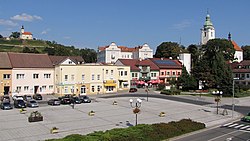Bzenec
Bzenec | |
|---|---|
 View of Bzenec centre | |
| Coordinates: 48°58′24″N 17°16′0″E / 48.97333°N 17.26667°E | |
| Country | |
| Region | South Moravian |
| District | Hodonín |
| First mentioned | 1231 |
| Government | |
| • Mayor | Erik Ebringer |
| Area | |
| • Total | 40.34 km2 (15.58 sq mi) |
| Elevation | 183 m (600 ft) |
| Population (2023-01-01)[1] | |
| • Total | 4,565 |
| • Density | 110/km2 (290/sq mi) |
| Time zone | UTC+1 (CET) |
| • Summer (DST) | UTC+2 (CEST) |
| Postal code | 696 81 |
| Website | www |
Bzenec (Czech pronunciation: [ˈbzɛnɛts]; German: Bisenz) is a town in Hodonín District in the South Moravian Region of the Czech Republic. It has about 4,600 inhabitants.
Geography[edit]
Bzenec is located about 16 kilometres (10 mi) northeast of Hodonín. Larger part of the municipal territory lies in a flat landscape of the Lower Morava Valley. The northern hilly part lies in the Kyjov Hills and include the highest point of Bzenec, Horní hory at 292 m (958 ft) above sea level. The town is situated on the Syrovinka stream.
History[edit]
The first written mention of Bzenec is from 1015, when the local Businc Castle was conquered by Duke Oldřich. Around 1230, Bzenec became a regional centre. In 1330, Bzenec was first referred to as a town. First Jews settled here probably in the second half of the 14th century. The Jewish community belonged to the oldest in Moravia.[2]
The original castle on the hill above the town was badly damaged during the Hussite Wars and demolished in the late 15th century. A new late Gothic fortress was built right in the town. In the 16th century, it was rebuilt into a Renaissance castle.[2][3] Until 1514, the Bzenec estate was owned by the royal chamber, although it was often pawned.[4]
The first reliable mentions of the Jewish community date back to the 16th century. The Jews were permitted to own vineyards, which, together with the town's convenient location on the trade route, were the reasons why they settled here.[5] In 1605, the town was severely damaged by the army of Stephen Bocskai. Bzenec further suffered during the Thirty Years' War. The Jewish community was completely destroyed. The town recovered only slowly.[5][6]
When the estate was owned by Count Erdmann Kryštof Pruskovský of Pruskov, the castle was baroque rebuilt by design of Domenico Martinelli in 1709–1710. The castle garden was rebuilt partly into a French formal garden and partly into an English park. In 1852, Count Vilém of Reichenbach had demolished the Baroque castle and had built a new neo-Gothic castle in 1855–1858. As a result, the count became very indebted, which eventually led to his suicide, and the second floor of the castle remained unfinished.[3]
Demographics[edit]
|
|
| ||||||||||||||||||||||||||||||||||||||||||||||||||||||
| Source: Censuses[7][8] | ||||||||||||||||||||||||||||||||||||||||||||||||||||||||
Economy[edit]
Bzenec is known for viticulture and wine production. The town also has a tradition of growing fruit and vegetables. Pickled cucumbers and vegetable salads are mainly produced here.[2]
Bzenec is also known for the vinegar production. The vinegar plant was founded here in 1864.[9]
Transport[edit]
Bzenec is located on the railway lines Brno–Staré Město and Kyjov–Veselí nad Moravou.[10]
Sights[edit]

The castle fell into disrepair and today is owned by the town. It is inaccessible. The castle park is open to the public.[3] In the park is a tree known as Bzenec Linden, which is supposedly more than 900 years old.[11]
The landmark of the town is the Chapel of Saints Florian and Sebastian. It was built in 1703 on the hill above the town, on the site where the old castle stood. Due to its location, the chapel was struck several times by lightning, then it was destroyed during World War II. The chapel was restored only recently, and was opened in 2018.[12]
Notable people[edit]
- Rudolf Auspitz (1837–1906), Austrian industrialist, economist; lived here
- Nehemiah Brüll (1843–1891), rabbi; lived here
- Max Kurzweil (1867–1916), Austrian painter, graphic artist
- Norbert Jokl (1877–1942), Austrian linguist, father of Albanology
Twin towns – sister cities[edit]
 Egeln, Germany
Egeln, Germany Mûrs-Erigné, France
Mûrs-Erigné, France
References[edit]
- ^ "Population of Municipalities – 1 January 2023". Czech Statistical Office. 23 May 2023.
- ^ a b c "Historie města" (in Czech). Město Bzenec. Retrieved 3 December 2021.
- ^ a b c "Zámek" (in Czech). Starý Bzenec. Retrieved 3 December 2021.
- ^ "Majitelé bzeneckého panství" (in Czech). Starý Bzenec. Retrieved 3 December 2021.
- ^ a b "Židovská obec ve Bzenci" (in Czech). Starý Bzenec. Retrieved 3 December 2021.
- ^
 This article incorporates text from a publication now in the public domain: Gotthard Deutsch, Josef Hoff (1901–1906). "Bisenz". In Singer, Isidore; et al. (eds.). The Jewish Encyclopedia. New York: Funk & Wagnalls.
This article incorporates text from a publication now in the public domain: Gotthard Deutsch, Josef Hoff (1901–1906). "Bisenz". In Singer, Isidore; et al. (eds.). The Jewish Encyclopedia. New York: Funk & Wagnalls.
- ^ "Historický lexikon obcí České republiky 1869–2011 – Okres Hodonín" (in Czech). Czech Statistical Office. 21 December 2015. pp. 1–2.
- ^ "Population Census 2021: Population by sex". Public Database. Czech Statistical Office. 27 March 2021.
- ^ "Historie Bzenecké octárny" (in Czech). Bzenecký ocet. 23 November 2015. Retrieved 3 December 2021.
- ^ "Detail stanice Bzenec" (in Czech). České dráhy. Retrieved 8 November 2023.
- ^ "Bzenecká lípa" (in Czech). Město Bzenec. Retrieved 3 December 2021.
- ^ "Kaple sv. Floriána a Šebestiána" (in Czech). Město Bzenec. Retrieved 3 December 2021.
- ^ "Partnerská města" (in Czech). Město Bzenec. Retrieved 3 December 2021.




